I thought this was about rat nutrition....and what to feed the rat if you felt the urge to keep a wild one.
Navigation
Install the app
How to install the app on iOS
Follow along with the video below to see how to install our site as a web app on your home screen.
Note: This feature may not be available in some browsers.
More options
You are using an out of date browser. It may not display this or other websites correctly.
You should upgrade or use an alternative browser.
You should upgrade or use an alternative browser.
Umm... So my dad found this baby Rat.......
- Thread starter sunnibunny99
- Start date
- Thread starter
- #22
The rats like....
[_________________} this long maybe?
and about....
_
_
This wide?

[_________________} this long maybe?
and about....
_
_
This wide?

If that size is acurate that sounds more like a mouse than a rat...a baby rat with its eyes open would be much larger. Either way you should provide a good rat food (oxbow or reggie rat are decent and easier to find than some others)....you could do Kaytee Forti-Diet (NOT the crunch, and NOT the old formula that uses ethoxyquin as a preservative). I would also supply KMR (kitten milk replacer....actual KMR not another brand). Wild mouse and rat babies usually can be tamed...
Wild and domesticated rats are as different as wild wolves and domesticated dogs.
very true.....but wolves can be tamed. There are many people that keep wolves as "pets" and claim them to be the more loyal and affectionate than any dog they'd ever met. That doesn't apply to all, and they should still be treated with the respect and caution that any wild animal deserves.....but wolves, and mice and rats, can be tamed quite well. The biggest issue with raising wild mice/rats is that, being wild animals, they do NOT like to be kept contained and will often do everything in their power to escape when they are left alone in their cage.
very true.....but wolves can be tamed. There are many people that keep wolves as "pets" and claim them to be the more loyal and affectionate than any dog they'd ever met. That doesn't apply to all, and they should still be treated with the respect and caution that any wild animal deserves.....but wolves, and mice and rats, can be tamed quite well. The biggest issue with raising wild mice/rats is that, being wild animals, they do NOT like to be kept contained and will often do everything in their power to escape when they are left alone in their cage.
Quote:
With most species of wild animals, this is true. However, pet rats and wild rats (not talking about the wood rats in the forests we have out here in the West, but Norway rats) are the exact same species. They are notorious for their adaptability. If this young one is treated with kindness as one would a pet, it will become a pet! As for diseases, the diseases they carry are due to any parasite load (esp. FLEAS, etc), and if given a flea bath and kept in a clean environment, disease is not an issue any more than pet store rats. I think it's pretty cool that your dad would even think of giving the critter a good life!
This is not true. Wild and domesticated rats are as different as wild wolves and domesticated dogs. I knew someone who raised a litter of baby wild rats that were born to a domestic female who had escaped. These babies were not friendly, and this woman is a very experienced rat person. She tried to hand raised them and they were always wild, always fearful, and always tried to bite. Wild animals, especially rodents, never lose their fear! Baby rats are independent and ready to breed at 5 weeks of age. They are still tiny, and look like helpless babies, but they aren't.
I would say let the rat go.
I continue to disagree.
Norway rats have evolved and adapted to human activity. They are the exact same species (Rattus norvegicus) as pet store rats, which have been selectively bred to be docile and colorful. Wolves (Canis lupus) and dogs (Canis domesticus) are different species.
I say give it a try...I'd love to see if it works out! Worst case scenario is that it doesn't. You can decide what to do from there....
With most species of wild animals, this is true. However, pet rats and wild rats (not talking about the wood rats in the forests we have out here in the West, but Norway rats) are the exact same species. They are notorious for their adaptability. If this young one is treated with kindness as one would a pet, it will become a pet! As for diseases, the diseases they carry are due to any parasite load (esp. FLEAS, etc), and if given a flea bath and kept in a clean environment, disease is not an issue any more than pet store rats. I think it's pretty cool that your dad would even think of giving the critter a good life!
This is not true. Wild and domesticated rats are as different as wild wolves and domesticated dogs. I knew someone who raised a litter of baby wild rats that were born to a domestic female who had escaped. These babies were not friendly, and this woman is a very experienced rat person. She tried to hand raised them and they were always wild, always fearful, and always tried to bite. Wild animals, especially rodents, never lose their fear! Baby rats are independent and ready to breed at 5 weeks of age. They are still tiny, and look like helpless babies, but they aren't.
I would say let the rat go.
I continue to disagree.
Norway rats have evolved and adapted to human activity. They are the exact same species (Rattus norvegicus) as pet store rats, which have been selectively bred to be docile and colorful. Wolves (Canis lupus) and dogs (Canis domesticus) are different species.
I say give it a try...I'd love to see if it works out! Worst case scenario is that it doesn't. You can decide what to do from there....
Last edited:
wolves and dogs are the same species....dogs are considered by SOME to be a subspecies.
Give it a little bowl of original soy milk.
- Jun 15, 2008
- 4,654
- 96
- 251
I kept several "wild" mice growing up. They tamed just fine even when captured as adults. They were as easy to handle as my gerbils if not more so since they weren't as hyper. Wild animals rarely carry disease as often as people fear. The thing is those we find are often out in the open and not avoiding us because they are sick. The ones that aren't sick we don't get much chance to interact with.
Domestic versions of rodents and most small animals is not usually comparable to the level of dogs and our common cats. There are a few breeds that have been bred to retain the characteristics of their ancestors but most are hardly even the same species anymore. They've been so selectively bred that both their phenotype and genetics are extremely different. Most small animals I know have been domesticated for a tiny percentage of that time. Some were even domesticated as few as 30-50years ago. Those that were domesticated earlier were mostly kept around more as a food source or for training other animals like dogs so they were not selectively bred to the extent dogs and cats were. Their popularity as pets and companions is more recent and their personalities and variances between different breeding stock show that. Even the guinea pig really could have come a much longer way as a pet than it currently has if people bred more selectively for temperament but it's not considered as important as looks and color so most still have much of their original instincts to flee human contact. They really aren't that well domesticated and not really any tamer than the guinea pigs running loose in peru that are used as a meat source there. I've also raised orphaned cottontails and successfully released them as near adults. They are a bit more high strung than their domestic counterparts (which are a different species from a different continent) but otherwise they can learn to interact just as well with humans and bear confinement just as well if raised to it. The differences I've seen between tamed rodents or small pets and wild are only as great as the differences found between calmer and more high strung individuals amongst the domestics. Due to personality differences some will tame better than others just like some decendents of domestic stock will be easier to handle than others.
Domestic versions of rodents and most small animals is not usually comparable to the level of dogs and our common cats. There are a few breeds that have been bred to retain the characteristics of their ancestors but most are hardly even the same species anymore. They've been so selectively bred that both their phenotype and genetics are extremely different. Most small animals I know have been domesticated for a tiny percentage of that time. Some were even domesticated as few as 30-50years ago. Those that were domesticated earlier were mostly kept around more as a food source or for training other animals like dogs so they were not selectively bred to the extent dogs and cats were. Their popularity as pets and companions is more recent and their personalities and variances between different breeding stock show that. Even the guinea pig really could have come a much longer way as a pet than it currently has if people bred more selectively for temperament but it's not considered as important as looks and color so most still have much of their original instincts to flee human contact. They really aren't that well domesticated and not really any tamer than the guinea pigs running loose in peru that are used as a meat source there. I've also raised orphaned cottontails and successfully released them as near adults. They are a bit more high strung than their domestic counterparts (which are a different species from a different continent) but otherwise they can learn to interact just as well with humans and bear confinement just as well if raised to it. The differences I've seen between tamed rodents or small pets and wild are only as great as the differences found between calmer and more high strung individuals amongst the domestics. Due to personality differences some will tame better than others just like some decendents of domestic stock will be easier to handle than others.
Give it a little bowl of original soy milk.
If the animal still needs milk soy milk does not contain the fat and proteins needed. They will basically starve on it. Cow milk is also unsuitable. Pretty much any form of milk we ingest is not suitable. If it still needs milk and I'm not sure what age rats are weaned then a milk replacer formula should be used. KMR for kittens is generally the most popular. I tend to use goat kid formula and raised a few gerbils as well as the cottontails on it. Those are mostly to entirely herbivorous animals though so the kitten milk might be a better option for something somewhat more carnivorous like a rat. Guinea pigs you never feed milk to since they are born fully capable of digesting an adult diet and guinea pig milk is very very weak. The babies can't digest the fats in most milk sources and unlike most mammal offspring are born lactose intollerant. For that reason they do best on guinea pig pellets moistened with unsweetened fruit juice until they can eat hay and pellets normally. Unfortunately I do not have any knowledge of rats directly so I can only give you examples of proper diets for other rodents and tell you that any milk you would buy at the store to drink is most likely not going to work.
If the animal still needs milk soy milk does not contain the fat and proteins needed. They will basically starve on it. Cow milk is also unsuitable. Pretty much any form of milk we ingest is not suitable. If it still needs milk and I'm not sure what age rats are weaned then a milk replacer formula should be used. KMR for kittens is generally the most popular. I tend to use goat kid formula and raised a few gerbils as well as the cottontails on it. Those are mostly to entirely herbivorous animals though so the kitten milk might be a better option for something somewhat more carnivorous like a rat. Guinea pigs you never feed milk to since they are born fully capable of digesting an adult diet and guinea pig milk is very very weak. The babies can't digest the fats in most milk sources and unlike most mammal offspring are born lactose intollerant. For that reason they do best on guinea pig pellets moistened with unsweetened fruit juice until they can eat hay and pellets normally. Unfortunately I do not have any knowledge of rats directly so I can only give you examples of proper diets for other rodents and tell you that any milk you would buy at the store to drink is most likely not going to work.
Last edited:
Actually, there is a DNA difference between Canis lupus and Canis domesticus
http://news.bbc.co.uk/1/hi/sci/tech/4965516.stm
(0.2% is the difference)
http://news.bbc.co.uk/1/hi/sci/tech/4965516.stm
(0.2% is the difference)
Mice, and I believe rats, are at least as distant from their wild brethren as dogs and wolves........the time span in years that they've been domesticated may be much shorter...but you also have to remember that they reproduce exponentially faster than dogs and cats....mice and rats are normally able to reproduce by 6 weeks of age, can reproduce about once a month, and can have litters anywhere from a few to over 20.....dogs and cats normally can't breed until around 6 months and tend to have smaller litters and can not breed anywhere near as often. There just has not been as drastic a physical change in mice and rats as the most drastic of physical mutations have not been intentionally bred for....though there have been significant changes from wild specimens...
wild house mouse...

and agouti ("wild" colored) english mouse (photo by Eric Jukes)

english show mouse next to a fancy that's probably about wild mouse size

A couple different coat varieties and colors of domestic mice
from www.hiiret.fi



a couple of my own mice...


photo by flickr member PETz*εїз II

photo from http://www.freewebs.com/whiskersntailsmousery (this is a manx)

...and those are only SOME of the varieties...there's a lot of different stuff in labs too. At any rate...you can't use length of time as a comparison for domestication between species. Dogs and wolves make a darn good comparison for mice and rats to their wild brethren, and that includes behavior....mice and rats have been bred similarly to dogs when it comes to behavior...they have all been bred to remain more like young animals than normal adults. Domestic mice/rats/dogs behave more like young animals...being less territorial, slightly less intelligent, more adaptable, and with lessened natural instincts....Hand raised wild mice/rats or wolves will always be wild animals who must be respected; they will have their instincts fully intact and will react to things as such....though they can be very tame and friendly.
oh wanted to add....sorry for the hijacking of the thread!
wild house mouse...

and agouti ("wild" colored) english mouse (photo by Eric Jukes)
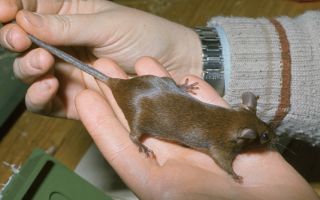
english show mouse next to a fancy that's probably about wild mouse size

A couple different coat varieties and colors of domestic mice
from www.hiiret.fi
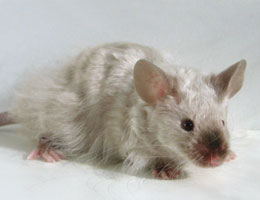
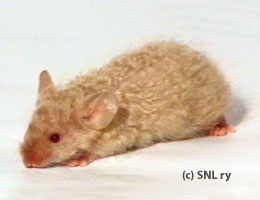
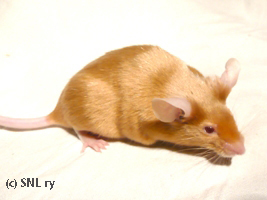
a couple of my own mice...
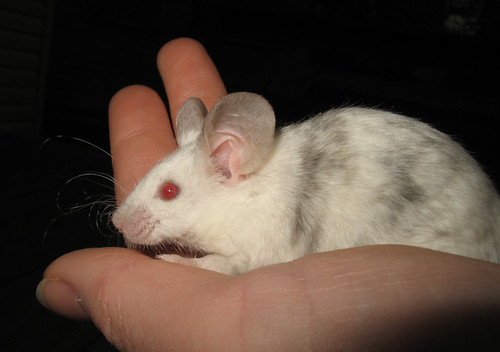
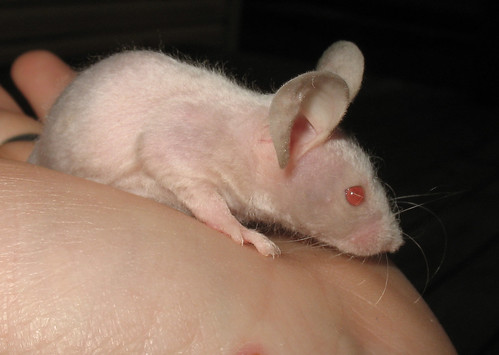
photo by flickr member PETz*εїз II
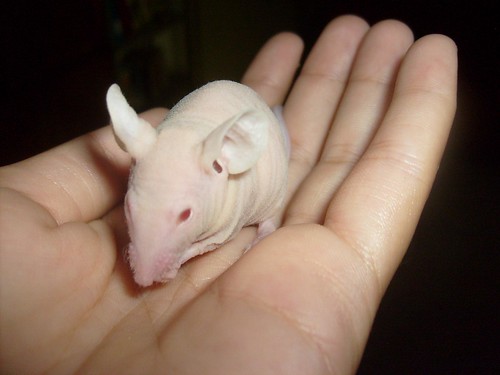
photo from http://www.freewebs.com/whiskersntailsmousery (this is a manx)
...and those are only SOME of the varieties...there's a lot of different stuff in labs too. At any rate...you can't use length of time as a comparison for domestication between species. Dogs and wolves make a darn good comparison for mice and rats to their wild brethren, and that includes behavior....mice and rats have been bred similarly to dogs when it comes to behavior...they have all been bred to remain more like young animals than normal adults. Domestic mice/rats/dogs behave more like young animals...being less territorial, slightly less intelligent, more adaptable, and with lessened natural instincts....Hand raised wild mice/rats or wolves will always be wild animals who must be respected; they will have their instincts fully intact and will react to things as such....though they can be very tame and friendly.
oh wanted to add....sorry for the hijacking of the thread!
Last edited:
sooo how is the little guy doing????
New posts New threads Active threads
-
Latest threads
-
Question of the Day - Sunday, November 30th, 2025
- Started by casportpony
- Replies: 3
-
Anyone know more of the Genetics behind these Buff Silkies?
- Started by realenthusiast
- Replies: 2
-
-
-
-
-
Threads with more replies in the last 15 days
-
-
-
-
Chicken Butt Emergency ‼️ Please Help!
- Started by urlocalcrazychickenlady
- Replies: 65
-
Open Contest BYC Poultry Caption Contest 11-28-25 Pic by Ponypoor
- Started by TwoCrows
- Replies: 49
-
×

